Hokkaido’s History, Culture and Nature
Encounter between Cultures from the North and the South – Okhotsk Culture and Satsumon Culture
In the late post-Jomon years, the Okhotsk culture spread from Sakhalin (Karafuto) to the area along the Sea of Okhotsk in Hokkaido and the Kurile Islands. At the same time, the Satsumon culture, a culture unique to Hokkaido influenced by culture in Honshu, took root following the post-Jomon culture. Movement of people and goods from the north and south increased, and helped to create the ethos of the subsequent Ainu culture.
Okhotsk culture
In the fifth century, people with a significantly different culture than that of Hokkaido residents moved from Sakhalin (Karafuto) to the area along the Sea of Okhotsk in Hokkaido. This is called the Okhotsk culture.
This Okhotsk culture also spread to the area along the Sea of Japan, and its remains have even been found on Okushiri Island in southern Hokkaido.
However, although remains of the Okhotsk culture have been found in the area along the Sea of Okhotsk, such remains have not been found in inland areas. These people are also called “marine people.”
The people of the Okhotsk culture were engaged in fishing and hunting of whales, seals and other marine animals, they kept dogs and pigs, and traded with people from the continent and Honshu (the main island of Japan). They also established settlements in coastal areas, and lived in pentagonal or hexagonal pit dwellings, some of which were very large, measuring over 10 m in length. It is thought that more than 15 people lived together in such a large dwelling.
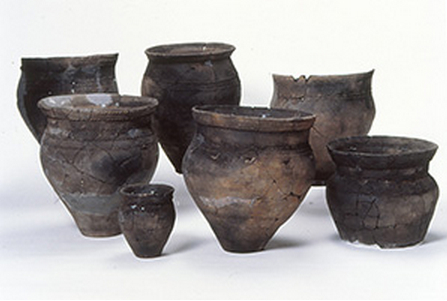
Okhotsk-type pottery is characteristically jar-shaped with a large opening at the mouth and a thin, clay string pattern. Since this thin, clay string pattern resembles the shape of somen (thin noodles), it is also called “somen pattern” or “pasted pattern”
(Tokoro Ruins Forest collection).
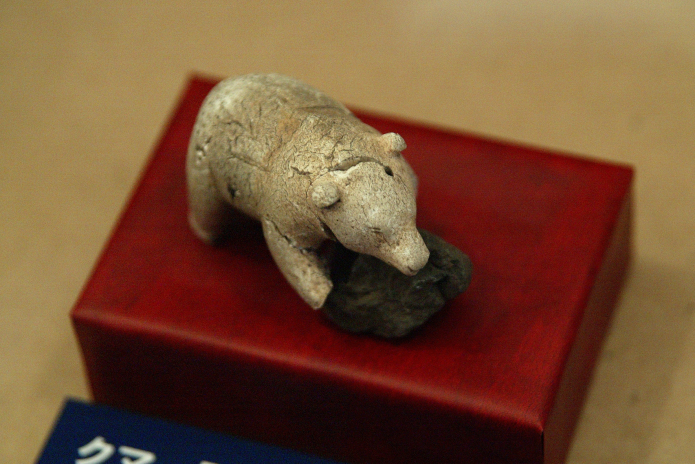
This figure represents an entire detailed bear. It is thought that bears were treated as special animals in the Okhotsk culture
(Tokoro Ruins Forest collection)
Ornaments on belts, nephrite, small bells and Japanese spears have been found at Okhotsk culture sites. These are similar to those found at Mohe culture (4th – 9th centuries) and Tongren culture (5th – 10th centuries) sites in the middle and downstream basin of the Amur River (Heilong Jiang).
This indicates that the Okhotsk culture was involved in trade and other exchanges with Sakhalin (Karafuto) and the continent.
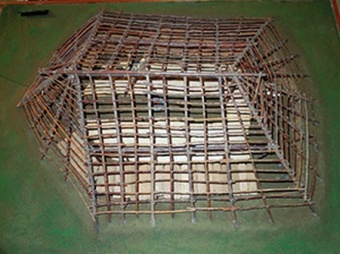
Pit dwellings of the Okhotsk culture are characterized by a planar pentagonal or hexagonal shape and a stone fireplace
(Photo courtesy of Tokoro Ruins Forest)

Approximately 10 ivory sculptures, which are unique to the Okhotsk culture, have been found in Hokkaido
(Hokkaido Museum of Northern Peoples collection).
Satsumon culture
Under the influence of the Honshu culture, Jomon pottery and stoneware were replaced with earthenware like Haji pottery in Honshu and ironware.
This culture is called Satsumon culture, and continued through the 7th to 12th centuries. Satsumon people lived in square pit dwellings with a cooking stove, which were also found in Honshu during the same period. In the 8th century, the people established settlements near estuaries, where they caught salmon and trout, gathered wild plants, and cultivated foxtail millet, millet and barley.
During this period, Hokkaido was actively engaged in exchanges with the Tohoku region and was influenced by it. Ironware obtained through trade rapidly spread, and stoneware was no longer in use. Smithery skills involved in the processing of the iron were also imported.
In Ebetsu City and Eniwa City, Makki Kofun (ancient burial mounds) reminiscent of those in the Tohoku region have been found, and contained such burial goods as ironware from Honshu.
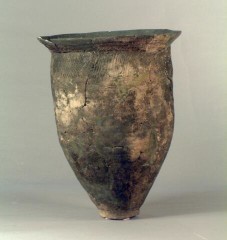
This piece of pottery is from the latter half of the Satsumon period. The surface had been finished by scraping it with a wooden spatula
(Hokkaido Museum collection).
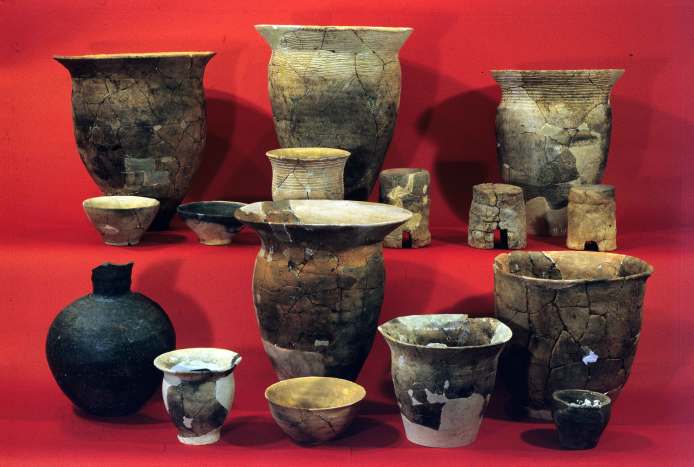
Numerous pieces of Satsumon pottery and Sue-ware have been unearthed at the K-446 Site found in Asabu, Kita-ku, Sapporo
(Sapporo Buried Cultural Properties Center).
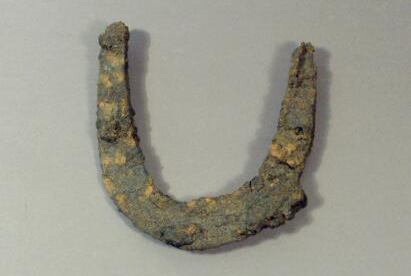
The tip of an iron spade: it has a blade on the outside and a groove on the inside. This is an example of the pieces of ironware that had been brought from Honshu
(Hokkaido Museum collection).
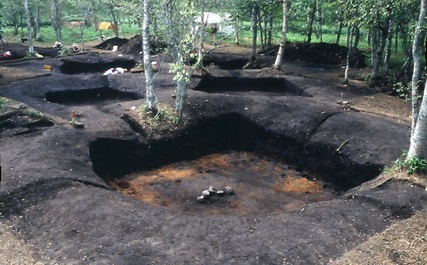
This is the largest settlement from the Satsumon period, and 2,549 dwellings have been found
(Photo courtesy of Shibetsu Pogawa Historical Place Forest Park).
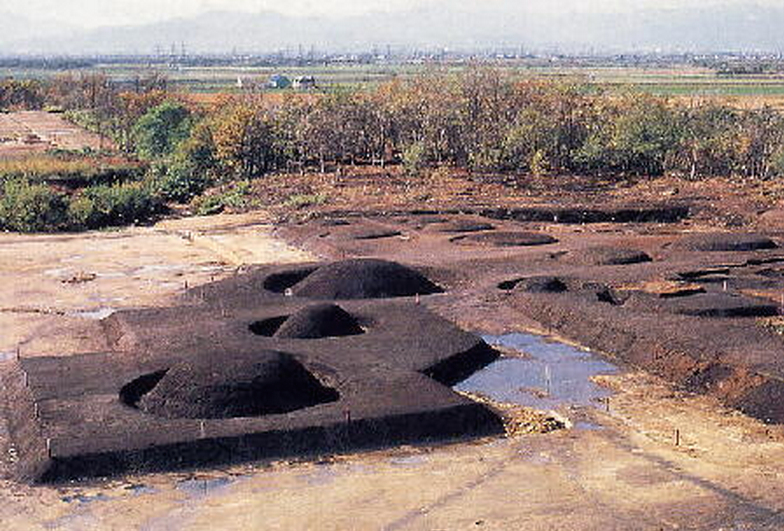
The Ebetsu Kofun mounds are thought to be of the same genealogy as those in the northern Tohoku region, and the only existing Kofun remains at the northern limit. They were found by Juichi Goto in 1931
(Photo courtesy of Ebetsu City Historical Museum).
Meeting between northern and southern cultures, which led to the Ainu culture
The Okhotsk culture (5th to 9th centuries) and the Satsumon culture (7th to 12th centuries) met in Hokkaido somewhere between 8th and 9th centuries.
In the 10th century, after the Okhotsk culture had ended, pottery showing characteristics of both the Okhotsk culture and the Satsumon culture was created. This pottery style is called Tobinitai pottery. The dwellings also had characteristics of both cultures. Remains have not only been found in coastal areas, but also in inland riverside areas like the Satsumon culture.
This indicates that the Okhotsk people in this area began to adopt a similar lifestyle as that of the Satsumon culture. The subsequent Ainu culture inherited elements of both the Okhotsk and Satsumon cultures.
Meanwhile, the central government in the south began to incorporate powerful clans in Tohoku referred to as Emishi. In the 12th century, the Hiraizumi culture prospered with the Fujiwara clan in Oshu and other powerful clans in Tohoku.
In the 13th and 14th centuries, Japanese people began to live in southern Hokkaido. Chinaware and iron pots spread to Hokkaido, and earthenware was no longer being made. Pit dwellings were replaced by flat-land dwellings, and fireplaces were used instead of cooking stoves. The Satsumon culture changed into the Ainu culture.
In this way, the culture of Hokkaido was affected by other area’s cultures through trade and other exchanges with people from the north and the south.
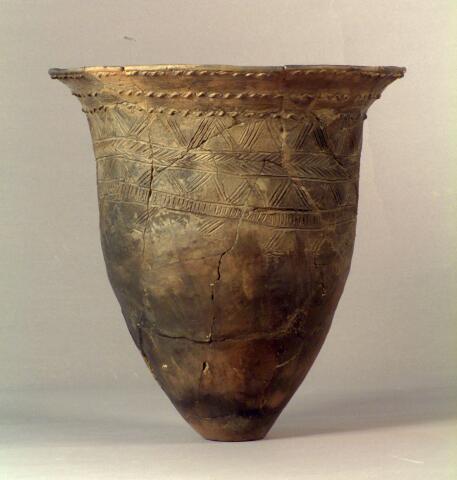
This piece of pottery incorporates the characteristics of both Satsumon and Okhotsk-type pottery in terms of shape and pattern. The pottery is called Tobinitai, because it was unearthed in the Tobinitai area of Urausu Town
(Hokkaido Museum collection).
Museums providing more information about the Okhotsk and Satsumon cultures
Village for Okhotsk people
Moyoro Shell Mound Museum (Abashiri Municipal Museum Annex
Moyoro Shell Mound is located at the mouth of the Abashiri River, and represents a settlement of the Okhotsk culture dating to approximately 1,300 years ago. This museum features exhibits showing the life of the Moyoro people under the themes of housing, graves and shell mounds. Visitors can learn details of the Okhotsk culture including their high-level navigation, marine animal hunting and fishing skills.
Base for research on northern peoples
Hokkaido Museum of Northern Peoples
This is a rare museum in the world that features exhibits of the food, clothing and housing as well as spiritual cultures of northern peoples, such as the Ainu, Nivkh, Yakut, Aleut and Inuit, all of whom live in northern areas. Exhibits on the lifestyle, religious, rituals and mysteries of the Okhotsk culture are also on display.
Experience the town of ruins
Tokoro Ruins Forest
The Tokoro Ruins Forest is a vast deciduous woodland featuring Daimyo oak and Japanese oak trees, and a historical park encompassing settlement remains from the Jomon, post-Jomon and Satsumon periods. Situated around the forest are Tokoro Iseki-no-Yakata (Tokoro Ruins Museum), the Tokoro Buried Cultural Treasure Center, and the Tokoro Museum of the University of Tokyo Faculty of Letters, where excavated materials are on display.
Compilation of research on the Okhotsk culture by Hokkaido University
Hokkaido University Museum
This museum on the campus of Hokkaido University houses and exhibits a collection of archaeological materials from the five major Okhotsk culture sites (Kabukai 1 Site and Motochi Site on Rebun Island, Onkoromanai Site in Wakkanai City, Menashidomari Site in Esashi Town, and Moyoro Shell Mound in Abashiri City).
- AddressKita 10-jo Nishi 8-chome, Kita-ku, Sapporo
- Tel011-706-2658
- LinkHokkaido University Museum
Diorama of Ebetsu Kofun mounds
Ebetsu City Historical Museum
This museum exhibits the history of Ebetsu from the prehistoric age to modern times by theme. A diorama of the Ebetsu Kofun mounds is also on display. Approximately 400 pieces of pottery from the prehistoric age include post-Jomon and Satsumon pottery and Haji pottery from Honshu.
- AddressMidorimachi Nishi 1-chome 38, Ebetsu
- Tel011-385-6466
- LinkEbetsu City Historical Museum (In Japanese)
Remains from the Satsumon age in Sapporo
Sapporo Buried Cultural Properties Center
This center exhibits cultural remains in Sapporo and materials from the Paleolithic, Jomon, post-Jomon, Satsumon and Ainu periods.
- AddressMinami 22-jo Nishi 13-chome, Chuo-ku, Sapporo (next to Sapporo Chuo Library)
- Tel011-512-5430
- LinkSapporo Buried Cultural Properties Center (In Japanese)
Preservation of the largest Satsumon settlement remains
Shibetsu Pogawa Historical Place Forest Park
The Pogawa Historical Place Forest Park is comprised of three sections: an entrance area that includes a folk museum and a historic village; the Shibetsu Wetland, where marsh plants bloom; and the Ichani Karikariusu Site, a national historic site showing the footsteps of humankind over a course of approximately 10,000 years. It is a vast outdoor museum where the history, culture and nature of the area around Shiretoko merge into one.
- AddressIchani 2784, Shibetsu-cho, Shibetsu-gun
- Tel0153-82-3674
- LinkShibetsu Pogawa Historical Place Forest Park (In Japanese)
Place to comprehensively learn the history of Hokkaido from the prehistoric age
Hokkaido Museum
- LinkHokkaido Museum
